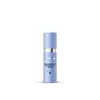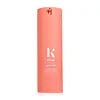What's inside
What's inside
 Key Ingredients
Key Ingredients

 Benefits
Benefits

 Concerns
Concerns

 Ingredients Side-by-side
Ingredients Side-by-side

Centella Asiatica Extract
CleansingWater
Skin ConditioningNiacinamide
SmoothingPropanediol
SolventGlycerin
HumectantButylene Glycol
HumectantCaprylic/Capric Triglyceride
MaskingPanthenol
Skin ConditioningAcrylates/C10-30 Alkyl Acrylate Crosspolymer
Emulsion StabilisingBetaine
Humectant1,2-Hexanediol
Skin ConditioningMyristoyl/Palmitoyl Oxostearamide/Arachamide Mea
Skin ConditioningAsiaticoside
AntioxidantMadecassic Acid
Skin ConditioningAsiatic Acid
Skin ConditioningMadecassoside
AntioxidantHydrolyzed Hyaluronic Acid
HumectantSodium Hyaluronate
HumectantDipotassium Glycyrrhizate
Humectant4-T-Butylcyclohexanol
MaskingCholesterol
EmollientPhytosterols
Skin ConditioningStearic Acid
CleansingCaprylamide Mea
AntioxidantHeptasodium Hexacarboxymethyl Dipeptide-12
Skin ConditioningMethyl Caprooyl Tyrosinate
Skin ProtectingHexacarboxymethyl Dipeptide-12
HumectantTetracarboxymethyl Hexanoyl Dipeptide-12
Skin ConditioningPentasodium Tetracarboxymethyl Palmitoyl Dipeptide-12
Skin ConditioningDihydroxyisopropyl Capryloylcaprylamide
Skin ProtectingCaprylyl Glycol
EmollientPentylene Glycol
Skin ConditioningAllantoin
Skin ConditioningArginine
MaskingZinc Gluconate
Skin ConditioningCarbomer
Emulsion StabilisingSorbitan Stearate
EmulsifyingCetearyl Alcohol
EmollientGlyceryl Stearate
EmollientBrassica Campestris Sterols
EmollientHydrogenated Lecithin
EmulsifyingSorbitan Laurate
EmulsifyingXanthan Gum
EmulsifyingHydroxyethylcellulose
Emulsion StabilisingDisodium EDTA
Centella Asiatica Extract, Water, Niacinamide, Propanediol, Glycerin, Butylene Glycol, Caprylic/Capric Triglyceride, Panthenol, Acrylates/C10-30 Alkyl Acrylate Crosspolymer, Betaine, 1,2-Hexanediol, Myristoyl/Palmitoyl Oxostearamide/Arachamide Mea, Asiaticoside, Madecassic Acid, Asiatic Acid, Madecassoside, Hydrolyzed Hyaluronic Acid, Sodium Hyaluronate, Dipotassium Glycyrrhizate, 4-T-Butylcyclohexanol, Cholesterol, Phytosterols, Stearic Acid, Caprylamide Mea, Heptasodium Hexacarboxymethyl Dipeptide-12, Methyl Caprooyl Tyrosinate, Hexacarboxymethyl Dipeptide-12, Tetracarboxymethyl Hexanoyl Dipeptide-12, Pentasodium Tetracarboxymethyl Palmitoyl Dipeptide-12, Dihydroxyisopropyl Capryloylcaprylamide, Caprylyl Glycol, Pentylene Glycol, Allantoin, Arginine, Zinc Gluconate, Carbomer, Sorbitan Stearate, Cetearyl Alcohol, Glyceryl Stearate, Brassica Campestris Sterols, Hydrogenated Lecithin, Sorbitan Laurate, Xanthan Gum, Hydroxyethylcellulose, Disodium EDTA
Water
Skin Conditioning3-O-Ethyl Ascorbic Acid
Skin ConditioningBifida Ferment Lysate
Skin ConditioningCentella Asiatica Extract
CleansingNiacinamide
SmoothingCamellia Sinensis Leaf Extract
AntimicrobialPanthenol
Skin ConditioningGlycerin
HumectantAvena Sativa Kernel Flour
AbrasiveResveratrol
AntioxidantPhenoxyethanol
PreservativeButylene Glycol
HumectantPolyacrylate Crosspolymer-6
Emulsion StabilisingPropylene Glycol
HumectantSodium Polyglutamate
HumectantSodium Lauroyl Lactylate
EmulsifyingSodium Acetylated Hyaluronate
HumectantSodium Hyaluronate
HumectantChlorphenesin
AntimicrobialDiisopropyl Adipate
EmollientPropanediol
SolventGlycyrrhiza Glabra Root Extract
BleachingCarnosine
Skin ConditioningPalmitamide Mea
Quercetin
AntioxidantSodium Metabisulfite
AntioxidantSodium Diethylenetriamine Pentamethylene Phosphonate
Lecithin
EmollientCarbomer
Emulsion StabilisingCeramide NP
Skin ConditioningSodium Gluceptate
Sodium Lactate
BufferingAcrylic Acid/Acrylamidomethyl Propane Sulfonic Acid Copolymer
Sodium Benzoate
MaskingAcetic Acid
BufferingCeramide AP
Skin ConditioningCholesterol
EmollientPhytosphingosine
Skin ConditioningPolysorbate 20
EmulsifyingXanthan Gum
EmulsifyingDimethylmethoxy Chromanol
AntioxidantGlyceryl Caprylate
EmollientLactic Acid
BufferingEthylhexylglycerin
Skin ConditioningPalmitoyl Tripeptide-1
Skin ConditioningPalmitoyl Tetrapeptide-7
Skin ConditioningCeramide EOP
Skin ConditioningWater, 3-O-Ethyl Ascorbic Acid, Bifida Ferment Lysate, Centella Asiatica Extract, Niacinamide, Camellia Sinensis Leaf Extract, Panthenol, Glycerin, Avena Sativa Kernel Flour, Resveratrol, Phenoxyethanol, Butylene Glycol, Polyacrylate Crosspolymer-6, Propylene Glycol, Sodium Polyglutamate, Sodium Lauroyl Lactylate, Sodium Acetylated Hyaluronate, Sodium Hyaluronate, Chlorphenesin, Diisopropyl Adipate, Propanediol, Glycyrrhiza Glabra Root Extract, Carnosine, Palmitamide Mea, Quercetin, Sodium Metabisulfite, Sodium Diethylenetriamine Pentamethylene Phosphonate, Lecithin, Carbomer, Ceramide NP, Sodium Gluceptate, Sodium Lactate, Acrylic Acid/Acrylamidomethyl Propane Sulfonic Acid Copolymer, Sodium Benzoate, Acetic Acid, Ceramide AP, Cholesterol, Phytosphingosine, Polysorbate 20, Xanthan Gum, Dimethylmethoxy Chromanol, Glyceryl Caprylate, Lactic Acid, Ethylhexylglycerin, Palmitoyl Tripeptide-1, Palmitoyl Tetrapeptide-7, Ceramide EOP
Ingredients Explained
These ingredients are found in both products.
Ingredients higher up in an ingredient list are typically present in a larger amount.
Butylene Glycol (or BG) is used within cosmetic products for a few different reasons:
Overall, Butylene Glycol is a safe and well-rounded ingredient that works well with other ingredients.
Though this ingredient works well with most skin types, some people with sensitive skin may experience a reaction such as allergic rashes, closed comedones, or itchiness.
Learn more about Butylene GlycolCarbomer is a polymer of acrylic acid. Its main role is to create a gel consistency.
A high amount of carbomer can cause pilling or balling up of products. Don't worry, most products contain 1% or less of carbomer.
Centella Asiatica Extract (Centella) is derived from an herb native to Southeast Asia. It is famous for its anti-inflammatory and soothing properties.
Centella is rich in antioxidants and amino acids, such as Madecassic Acid and Asiaticoside.
Studies show the compounds in centella help with:
The combination of all these properties makes centella effective at soothing, hydrating, and protecting the skin.
Other great components of centella include Vitamin A, vitamin C, several B vitamins, and Asiatic Acid.
Fun fact: Centella has been used as a medicine and in food for many centuries. As a medicine, it is used to treat burns, scratches, and wounds.
Learn more about Centella Asiatica ExtractCholesterol is a class of organic molecules called lipids. It helps hydrate your skin and is essential to having a healthy skin barrier.
Our skin naturally contains cholesterol in the outermost layer. Besides cholesterol, it also contains ceramides and fatty acids. Cholesterol makes up about 1/4 of your skin's outer layer and barrier. Your skin barrier is responsible for keeping allergens and microbes out. Having a healthy skin barrier is also responsible for keeping your skin firm and plump.
Our bodies use cholestrol to create vitamin D, steroid hormones, and more.
Learn more about CholesterolGlycerin is already naturally found in your skin. It helps moisturize and protect your skin.
A study from 2016 found glycerin to be more effective as a humectant than AHAs and hyaluronic acid.
As a humectant, it helps the skin stay hydrated by pulling moisture to your skin. The low molecular weight of glycerin allows it to pull moisture into the deeper layers of your skin.
Hydrated skin improves your skin barrier; Your skin barrier helps protect against irritants and bacteria.
Glycerin has also been found to have antimicrobial and antiviral properties. Due to these properties, glycerin is often used in wound and burn treatments.
In cosmetics, glycerin is usually derived from plants such as soybean or palm. However, it can also be sourced from animals, such as tallow or animal fat.
This ingredient is organic, colorless, odorless, and non-toxic.
Glycerin is the name for this ingredient in American English. British English uses Glycerol/Glycerine.
Learn more about GlycerinNiacinamide is a multitasking form of vitamin B3 that strengthens the skin barrier, reduces pores and dark spots, regulates oil, and improves signs of aging.
And the best part? It's gentle and well-tolerated by most skin types, including sensitive and reactive skin.
You might have heard of "niacin flush", or the reddening of skin that causes itchiness. Niacinamide has not been found to cause this.
In very rare cases, some individuals may not be able to tolerate niacinamide at all or experience an allergic reaction to it.
If you are experiencing flaking, irritation, and dryness with this ingredient, be sure to double check all your products as this ingredient can be found in all categories of skincare.
When incorporating niacinamide into your routine, look out for concentration amounts. Typically, 5% niacinamide provides benefits such as fading dark spots. However, if you have sensitive skin, it is better to begin with a smaller concentration.
When you apply niacinamide to your skin, your body converts it into nicotinamide adenine dinucleotide (NAD). NAD is an essential coenzyme that is already found in your cells as "fuel" and powers countless biological processes.
In your skin, NAD helps repair cell damage, produce new healthy cells, support collagen production, strengthen the skin barrier, and fight environmental stressors (like UV and pollution).
Our natural NAD levels start to decline with age, leading to slower skin repair, visible aging, and a weaker skin barrier. By providing your skin niacinamide, you're recharging your skin's NAD levels. This leads to stronger, healthier, and younger looking skin.
Another name for vitamin B3 is nicotinamide. This vitamin is water-soluble and our bodies don't store it. We obtain Vitamin B3 from either food or skincare. Meat, fish, wheat, yeast, and leafy greens contain vitamin B3.
The type of niacinamide used in skincare is synthetically created.
Learn more about NiacinamidePanthenol is a common ingredient that helps hydrate and soothe the skin. It is found naturally in our skin and hair.
There are two forms of panthenol: D and L.
D-panthenol is also known as dexpanthenol. Most cosmetics use dexpanthenol or a mixture of D and L-panthenol.
Panthenol is famous due to its ability to go deeper into the skin's layers. Using this ingredient has numerous pros (and no cons):
Like hyaluronic acid, panthenol is a humectant. Humectants are able to bind and hold large amounts of water to keep skin hydrated.
This ingredient works well for wound healing. It works by increasing tissue in the wound and helps close open wounds.
Once oxidized, panthenol converts to pantothenic acid. Panthothenic acid is found in all living cells.
This ingredient is also referred to as pro-vitamin B5.
Learn more about PanthenolPropanediol is an all-star ingredient. It softens, hydrates, and smooths the skin.
It’s often used to:
Propanediol is not likely to cause sensitivity and considered safe to use. It is derived from corn or petroleum with a clear color and no scent.
Learn more about PropanediolSodium Hyaluronate is hyaluronic acid's salt form. It is commonly derived from the sodium salt of hyaluronic acid.
Like hyaluronic acid, it is great at holding water and acts as a humectant. This makes it a great skin hydrating ingredient.
Sodium Hyaluronate is naturally occurring in our bodies and is mostly found in eye fluid and joints.
These are some other common types of Hyaluronic Acid:
Learn more about Sodium HyaluronateWater. It's the most common cosmetic ingredient of all. You'll usually see it at the top of ingredient lists, meaning that it makes up the largest part of the product.
So why is it so popular? Water most often acts as a solvent - this means that it helps dissolve other ingredients into the formulation.
You'll also recognize water as that liquid we all need to stay alive. If you see this, drink a glass of water. Stay hydrated!
Learn more about WaterXanthan gum is used as a stabilizer and thickener within cosmetic products. It helps give products a sticky, thick feeling - preventing them from being too runny.
On the technical side of things, xanthan gum is a polysaccharide - a combination consisting of multiple sugar molecules bonded together.
Xanthan gum is a pretty common and great ingredient. It is a natural, non-toxic, non-irritating ingredient that is also commonly used in food products.
Learn more about Xanthan Gum